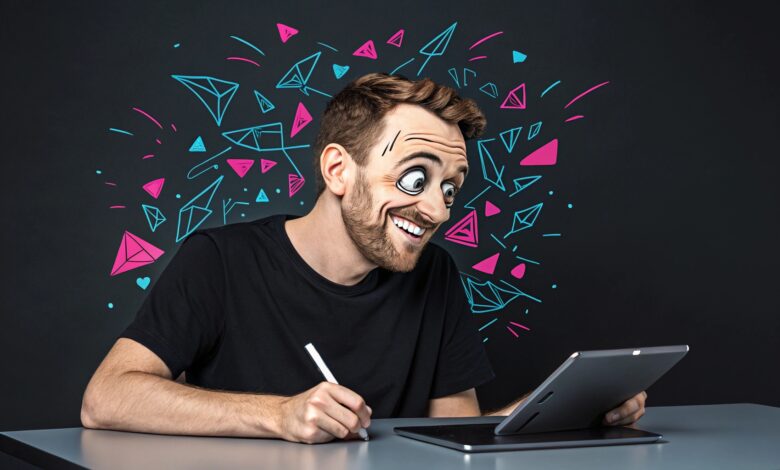Caricatronchi: The Digital Art Trend Redefining Expression

Caricatronchi: The Digital Art Trend Redefining Expression explores an emerging visual style that blends caricature, surrealism, and bold digital aesthetics. This article dives into how caricatronchi artists create expressive, fragmented works that challenge conventional portraits. Discover the tools, techniques, and platforms fueling its rise in digital culture and branding. We examine why U.S.-based creatives and marketers should pay attention to the caricatronchi phenomenon. Learn how this trend impacts social media visuals, personal branding, and contemporary art markets. Stay informed on caricatronchi’s potential and what it means for visual identity in the digital age.
Stay tuned with us — we will talk about Caricatronchi: The Digital Art Trend Redefining Expression.
Understanding the Concept of Caricatronchi
Caricatronchi is a fusion term combining “caricature” and “tronchi” (Italian for “trunks” or “fragments”), referring to a distinctive digital-art style that exaggerates features, fragments forms, and plays with surreal aesthetic. The style merges traditional caricature’s exaggeration with modern digital tools, creating portraits and visuals that feel both humorous and deeply symbolic. For U.S. readers and creatives, adopting caricatronchi means engaging with an art form that is expressive, shareable, and culturally relevant.
Origins and Evolution of Caricatronchi
The roots of caricatronchi lie in classical caricature (exaggerating features for effect) and art movements like surrealism and cubism (deconstructing form). As digital art and social media platforms expanded, artists began to combine these influences: bold colour palettes, fragmented anatomy, stylised exaggeration, and digital rendering. Over time caricatronchi emerged as its own genre—a trend identified by art commentators as part of the evolving digital-visual culture. This evolution highlights how aesthetics adapt with technology and audience preferences.
Defining Characteristics and Visual Style
Key Visual Traits
- Exaggerated facial features and body parts that emphasise expression or identity.
- Fragmented or abstracted forms—torsos, limbs or heads might be disjointed, stylised, or surreal.
- Vibrant colours, flat gradients, and bold outlines typical of digital illustration.
- Mix of humour, identity-play and symbolic distortion rather than pure comedic satire.
Emotional and Conceptual Layers
Caricatronchi often goes beyond visual oddity—it conveys emotional states, identity fragmentation, digital persona, or critique of visual culture. The style resonates with modern audiences because it reflects the blended, hyper-visual, self-curated online identities many of us present.
The Role of Digital Tools and Platforms
Digital art tools and platforms have accelerated the spread of caricatronchi style. Artists use software like Adobe Illustrator or Procreate, tablets and styluses, and increasingly AI-assisted image generation to experiment with distortion and form. Social media sites like Instagram, TikTok and Behance allow rapid sharing of these works. For U.S.-based creators or brand designers, mastering caricatronchi tools means gaining access to a highly visual trend that’s primed for digital consumption, animated stickers, NFTs or brand avatars.
Applications in Branding, Social Media and Personal Identity
Caricatronchi’s appeal extends beyond fine art—it has business, branding and identity uses.
- Personal branding: Custom caricatronchi portraits function as unique avatars, profile pictures or website graphics that stand out.
- Marketing and events: Brands use stylised caricature-based visuals for campaigns, immersive experiences or social-media assets.
- NFTs and digital collectibles: The exaggerated, expressive style translates effectively into the digital-asset market.
- Online identity and culture: The aesthetic resonates with younger, digitally native audiences who value visual distinctiveness and authenticity.
Thus, for U.S.-based professionals in creative or marketing fields, engaging with caricatronchi offers a visual edge and cultural currency.
Techniques for Creating Your Own Caricatronchi
- Begin with observing unique features of your subject: what stands out in their expression, posture or identity.
- Sketch the base caricature, exaggerating key traits—but maintain recognisability.
- Introduce fragmentation or abstraction: twist limbs, split forms, use symbolic elements to convey meaning.
- Use digital tools: line work, colour fills, gradients, layering, and experiment with distortion.
- Finalise with post-processing: refine outlines, adjust colour dynamics, explore animation or interactivity if desired.
- Share and iterate: post to digital platforms, gather feedback, refine style and build a visual portfolio.
Cultural Impact and Why Caricatronchi Matters
Caricatronchi reflects broader shifts in how we visualise identity and art. In an era of filters, avatars and digital personas, the exaggerated and fragmented forms of caricatronchi speak to how individuals see themselves and are seen online. It’s more than a trend—it’s a signpost for visual culture that values expression, authenticity and uniqueness. In U.S. contexts, this aesthetic challenges mainstream design norms and invites creators to experiment with bold, personal-centric visuals.
Challenges, Misuse and Ethical Considerations
While caricatronchi offers creative freedom, there are challenges:
- Exaggeration can risk stereotyping or misrepresenting identity if not handled thoughtfully.
- Over-distortion might reduce recognisability and reduce viewer connection.
- As the style becomes more commercial, there is a risk of visual fatigue or over-use.
- Ethical use of caricature often involves respecting subjects and avoiding harmful exaggeration.
For professional creators, balancing visual boldness with purposeful design and respect for subject matter is key.
Future Trends and Opportunities in Caricatronchi
Looking ahead, several trends are likely within the caricatronchi sphere:
- Integration of AR/VR: Animated caricatronchi avatars in virtual spaces or immersive apps.
- AI-assisted generation: Tools that help create stylised caricatures automatically from photos.
- Branded character ecosystems: Companies developing caricatronchi-style mascots or campaign visuals.
- Cross-media expansion: From digital art to motion graphics, NFTs, interactive web experiences.
For U.S.-based graphic professionals and digital marketers, staying ahead of these opportunities positions you for visual innovation and cultural relevance.
Conclusion
Caricatronchi is a vibrant, expressive art form that merges caricature, surrealism and digital design into a distinct visual style. It reflects our digitally mediated identities—fragmented, exaggerated, bold—and offers creators a way to craft visuals that stand out in today’s saturated media environment. U.S.-based marketers, artists and designers can leverage caricatronchi for personal branding, social-media campaigns, NFT ventures or transportive digital experiences. Creating caricatronchi involves observation, exaggeration, digital tools and meaningful visual intention. The cultural impact of this style goes beyond aesthetics; it signals how we choose to express identity, personality and emotion visually in the digital era. Challenges around recognisability, ethical representation and visual over-use must be navigated with care. As AR, AI and cross-media formats evolve, caricatronchi is positioned not just as a trend but as a visual language for the future. For those willing to explore, its opportunities are abundant, and the canvas is wide open.
FAQs
What is Caricatronchi?
Caricatronchi is a modern art style that combines caricature techniques with fragmented forms and bold digital aesthetics to explore identity and expression.
How is Caricatronchi different from traditional caricatures?
Unlike traditional caricatures focused mainly on humor or satire, caricatronchi emphasises surreal exaggeration, identity fragmentation and digital stylization.
Can anyone create Caricatronchi artwork?
Yes, with basic caricature understanding, digital tools and creative imagination, anyone can experiment with caricatronchi creation.
Where is Caricatronchi most commonly used?
It is popular on social media avatars, digital branding, NFTs, and expressive illustrations within the digital art community.
What should creators consider when using Caricatronchi for branding?
Creators should balance distinctiveness with recognizability, respect identity representation, and align visuals with brand message and audience context.



